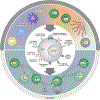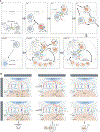T Follicular Helper Cell Biology: A Decade of Discovery and Diseases - PubMed (original) (raw)
Review
T Follicular Helper Cell Biology: A Decade of Discovery and Diseases
Shane Crotty. Immunity. 2019.
Abstract
Helping B cells and antibody responses is a major function of CD4+ T cells. It has been 10 years since the publication of Bcl6 as the lineage-defining transcription factor for T follicular helper (Tfh) differentiation and the requirement of Tfh cells as the specialized subset of CD4+ T cells needed for germinal centers (the microanatomical sites of B cell mutation and antibody affinity maturation) and related B cell responses. A great deal has been learned about Tfh cells in the past 10 years, particularly regarding their roles in a surprising range of diseases. Advances in the understanding of Tfh cell differentiation and function are discussed, as are the understanding of Tfh cells in infectious diseases, vaccines, autoimmune diseases, allergies, atherosclerosis, organ transplants, and cancer. This includes discussion of Tfh cells in the human immune system. Based on the discoveries to date, the next decade of Tfh research surely holds many more surprises. VIDEO ABSTRACT.
Copyright © 2019 Elsevier Inc. All rights reserved.
Figures
Figure 1.. Features of Tfh cells.
Tfh cell differentiation is induced by DCs in the presence of antigen and signals from the microenvironment. Tfh cell versus non-Tfh cell differentiation bifurcates early, based on the balance of inductive and inhibitory signals. Some intermediate cell fates are also possible (grey). Early Tfh cells then subsequently differentiate to GC-Tfh cells.
Figure 2.. Signals to and from Tfh cells.
Tfh cells receive signals from a number of cell types that can regulate Tfh differentiation and/or function. Tfh cells function by providing help to B cells at a series of stages of antigen-specific B cell differentiation. BAct, activated B cells. BGC, GC B cells. BPC, PC. Bpb, plasmablasts. BMem, memory B cells.
Figure 3.. Tfh and B cell response kinetics and interactions.
A. A time series of Tfh differentiation and function. Details of the steps are summarized in the main text. For simplicity, only one TF is indicated in each cell. TCF1 expression is retained in Tfh cells and not non-Tfh effector cells. An animated versions is included. B. Tfh functions and signals that regulate BGC cycling, BGC➔BPC differentiation, and BGC➔BMem differentiation. “Int” = intermediate.
Figure 4.. Relationships of Tfh cells to diseases.
Over the past decade Tfh cells have been associated with a wide range of diseases, with the Tfh cells contributing protective or pathogenic roles in different contexts, discussed in the main text.
Similar articles
- CD25(+) Bcl6(low) T follicular helper cells provide help to maturing B cells in germinal centers of human tonsil.
Li H, Pauza CD. Li H, et al. Eur J Immunol. 2015 Jan;45(1):298-308. doi: 10.1002/eji.201444911. Epub 2014 Oct 27. Eur J Immunol. 2015. PMID: 25263533 Free PMC article. - A Thpok-Directed Transcriptional Circuitry Promotes Bcl6 and Maf Expression to Orchestrate T Follicular Helper Differentiation.
Vacchio MS, Ciucci T, Gao Y, Watanabe M, Balmaceno-Criss M, McGinty MT, Huang A, Xiao Q, McConkey C, Zhao Y, Shetty J, Tran B, Pepper M, Vahedi G, Jenkins MK, McGavern DB, Bosselut R. Vacchio MS, et al. Immunity. 2019 Sep 17;51(3):465-478.e6. doi: 10.1016/j.immuni.2019.06.023. Epub 2019 Aug 15. Immunity. 2019. PMID: 31422869 Free PMC article. - Follicular Helper T Cells.
Vinuesa CG, Linterman MA, Yu D, MacLennan IC. Vinuesa CG, et al. Annu Rev Immunol. 2016 May 20;34:335-68. doi: 10.1146/annurev-immunol-041015-055605. Epub 2016 Feb 22. Annu Rev Immunol. 2016. PMID: 26907215 Review. - The development and function of follicular helper T cells in immune responses.
Chen M, Guo Z, Ju W, Ryffel B, He X, Zheng SG. Chen M, et al. Cell Mol Immunol. 2012 Sep;9(5):375-9. doi: 10.1038/cmi.2012.18. Epub 2012 Jun 4. Cell Mol Immunol. 2012. PMID: 22659733 Free PMC article. Review. - Repression of miR-31 by BCL6 stabilizes the helper function of human follicular helper T cells.
Ripamonti A, Provasi E, Lorenzo M, De Simone M, Ranzani V, Vangelisti S, Curti S, Bonnal RJP, Pignataro L, Torretta S, Geginat J, Rossetti G, Pagani M, Abrignani S. Ripamonti A, et al. Proc Natl Acad Sci U S A. 2017 Nov 28;114(48):12797-12802. doi: 10.1073/pnas.1705364114. Epub 2017 Nov 13. Proc Natl Acad Sci U S A. 2017. PMID: 29133396 Free PMC article.
Cited by
- Immuno-modulation by heat-killed Lacticaseibacillus paracasei MCC1849 and its application to food products.
Maehata H, Arai S, Iwabuchi N, Abe F. Maehata H, et al. Int J Immunopathol Pharmacol. 2021 Jan-Dec;35:20587384211008291. doi: 10.1177/20587384211008291. Int J Immunopathol Pharmacol. 2021. PMID: 33787390 Free PMC article. Review. - IL-23 Promotes a Coordinated B Cell Germinal Center Program for Class-Switch Recombination to IgG2b in BXD2 Mice.
Hong H, Gao M, Wu Q, Yang P, Liu S, Li H, Burrows PD, Cua D, Chen JY, Hsu HC, Mountz JD. Hong H, et al. J Immunol. 2020 Jul 15;205(2):346-358. doi: 10.4049/jimmunol.2000280. Epub 2020 Jun 17. J Immunol. 2020. PMID: 32554431 Free PMC article. - Interleukin-27 Functional Duality Balances Leishmania Infectivity and Pathogenesis.
Jafarzadeh A, Nemati M, Chauhan P, Patidar A, Sarkar A, Sharifi I, Saha B. Jafarzadeh A, et al. Front Immunol. 2020 Aug 7;11:1573. doi: 10.3389/fimmu.2020.01573. eCollection 2020. Front Immunol. 2020. PMID: 32849534 Free PMC article. Review. - Allogeneic HLA Humoral Immunogenicity and the Prediction of Donor-Specific HLA Antibody Development.
Jucaud V. Jucaud V. Antibodies (Basel). 2024 Jul 24;13(3):61. doi: 10.3390/antib13030061. Antibodies (Basel). 2024. PMID: 39189232 Free PMC article. Review. - The effect of prolactin on immune cell subsets involved in SLE pathogenesis.
Legorreta-Haquet MV, Santana-Sánchez P, Chávez-Sánchez L, Chávez-Rueda AK. Legorreta-Haquet MV, et al. Front Immunol. 2022 Oct 28;13:1016427. doi: 10.3389/fimmu.2022.1016427. eCollection 2022. Front Immunol. 2022. PMID: 36389803 Free PMC article. Review.
References
- Abbott RK, Lee JH, Menis S, Skog P, Rossi M, Ota T, Kulp DW, Bhullar D, Kalyuzhniy O, Havenar-Daughton C, et al. (2018). Precursor Frequency and Affinity Determine B Cell Competitive Fitness in Germinal Centers, Tested with Germline-Targeting HIV Vaccine Immunogens. Immunity 48, 133–146.e136. - PMC - PubMed
- Amara K, Steen J, Murray F, Morbach H, Fernandez-Rodriguez BM, Joshua V, Engström M, Snir O, Israelsson L, Catrina AI, et al. (2013). Monoclonal IgG antibodies generated from joint-derived B cells of RA patients have a strong bias toward citrullinated autoantigen recognition. J Exp Med 210, 445–455. - PMC - PubMed
Publication types
MeSH terms
Substances
Grants and funding
- R01 AI135193/AI/NIAID NIH HHS/United States
- U19 AI109976/AI/NIAID NIH HHS/United States
- U19 AI118610/AI/NIAID NIH HHS/United States
- UM1 AI100663/AI/NIAID NIH HHS/United States
LinkOut - more resources
Full Text Sources
Other Literature Sources
Research Materials
Miscellaneous



